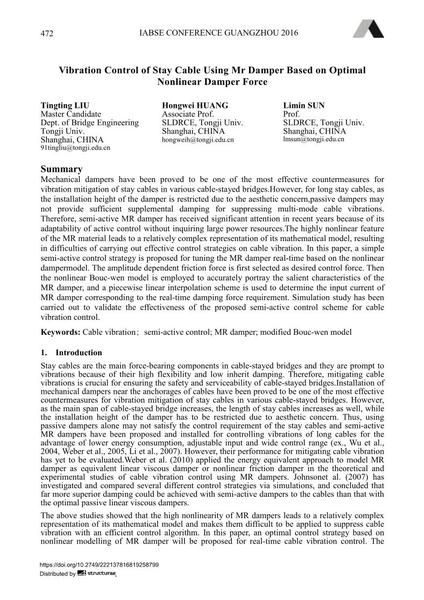Vibration Control of Stay Cable Using Mr Damper Based on Optimal Nonlinear Damper Force

|
|
|||||||||||
Bibliografische Angaben
| Autor(en): |
Tingting Liu
Hongwei Huang Limin Sun |
||||
|---|---|---|---|---|---|
| Medium: | Tagungsbeitrag | ||||
| Sprache(n): | Englisch | ||||
| Tagung: | IABSE Conference: Bridges and Structures Sustainability - Seeking Intelligent Solutions, Guangzhou, China, 8-11 May 2016 | ||||
| Veröffentlicht in: | IABSE Conference, Guangzhou, China, 8 – 11 May 2016 | ||||
|
|||||
| Seite(n): | 472-480 | ||||
| Anzahl der Seiten (im PDF): | 9 | ||||
| Jahr: | 2016 | ||||
| DOI: | 10.2749/222137816819258799 | ||||
| Abstrakt: |
Mechanical dampers have been proved to be one of the most effective countermeasures for vibration mitigation of stay cables in various cable-stayed bridges.However, for long stay cables, as the installation height of the damper is restricted due to the aesthetic concern,passive dampers may not provide sufficient supplemental damping for suppressing multi-mode cable vibrations. Therefore, semi-active MR damper has received significant attention in recent years because of its adaptability of active control without inquiring large power resources.The highly nonlinear feature of the MR material leads to a relatively complex representation of its mathematical model, resulting in difficulties of carrying out effective control strategies on cable vibration. In this paper, a simple semi-active control strategy is proposed for tuning the MR damper real-time based on the nonlinear dampermodel. The amplitude dependent friction force is first selected as desired control force. Then the nonlinear Bouc-wen model is employed to accurately portray the salient characteristics of the MR damper, and a piecewise linear interpolation scheme is used to determine the input current of MR damper corresponding to the real-time damping force requirement. Simulation study has been carried out to validate the effectiveness of the proposed semi-active control scheme for cable vibration control. |
||||
| Stichwörter: |
MR-Dämpfer
|
||||

